
peft
🤗 PEFT: State-of-the-art Parameter-Efficient Fine-Tuning.
Stars: 19677
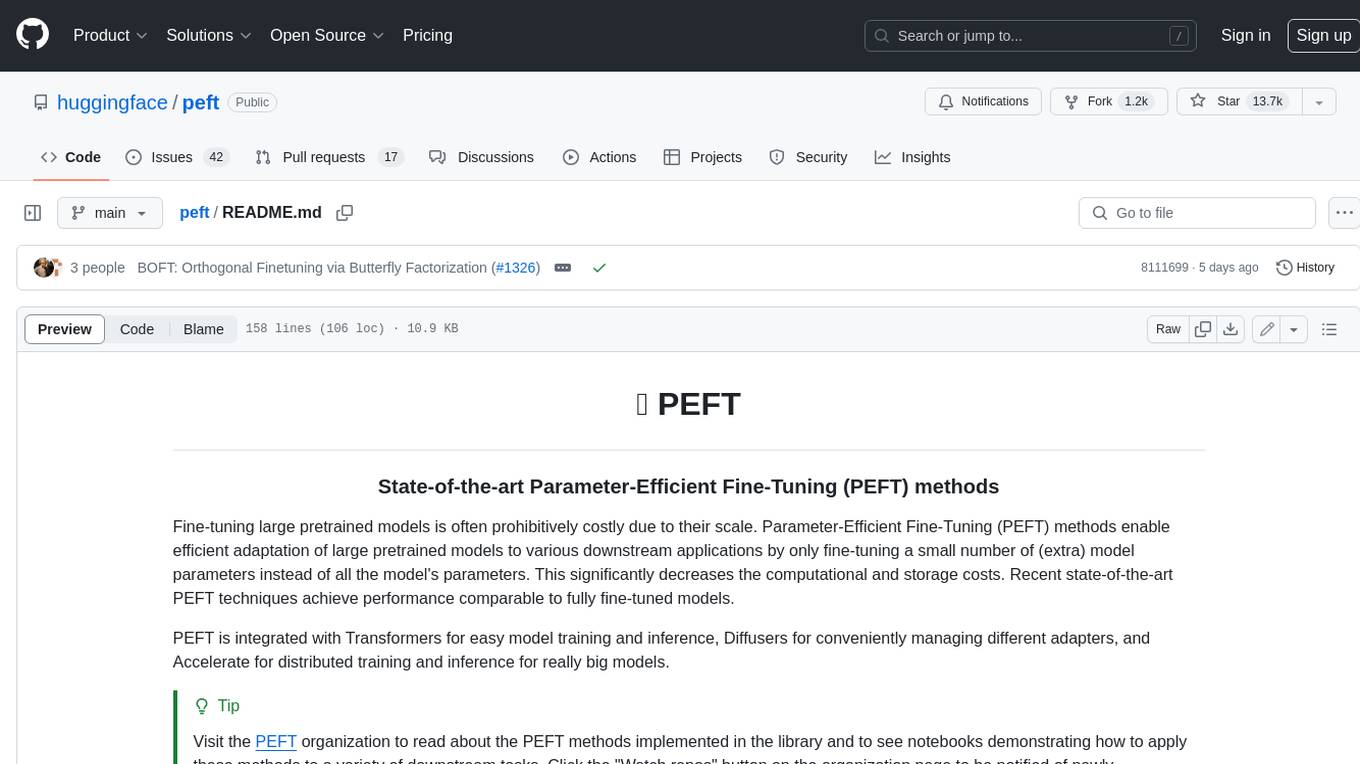
PEFT (Parameter-Efficient Fine-Tuning) is a collection of state-of-the-art methods that enable efficient adaptation of large pretrained models to various downstream applications. By only fine-tuning a small number of extra model parameters instead of all the model's parameters, PEFT significantly decreases the computational and storage costs while achieving performance comparable to fully fine-tuned models.
README:
🤗 PEFT
State-of-the-art Parameter-Efficient Fine-Tuning (PEFT) methods
Fine-tuning large pretrained models is often prohibitively costly due to their scale. Parameter-Efficient Fine-Tuning (PEFT) methods enable efficient adaptation of large pretrained models to various downstream applications by only fine-tuning a small number of (extra) model parameters instead of all the model's parameters. This significantly decreases the computational and storage costs. Recent state-of-the-art PEFT techniques achieve performance comparable to fully fine-tuned models.
PEFT is integrated with Transformers for easy model training and inference, Diffusers for conveniently managing different adapters, and Accelerate for distributed training and inference for really big models.
[!TIP] Visit the PEFT organization to read about the PEFT methods implemented in the library and to see notebooks demonstrating how to apply these methods to a variety of downstream tasks. Click the "Watch repos" button on the organization page to be notified of newly implemented methods and notebooks!
Check the PEFT Adapters API Reference section for a list of supported PEFT methods, and read the Adapters, Soft prompts, and IA3 conceptual guides to learn more about how these methods work.
Install PEFT from pip:
pip install peftPrepare a model for training with a PEFT method such as LoRA by wrapping the base model and PEFT configuration with get_peft_model. For the bigscience/mt0-large model, you're only training 0.19% of the parameters!
from transformers import AutoModelForCausalLM
from peft import LoraConfig, TaskType, get_peft_model
device = torch.accelerator.current_accelerator().type if hasattr(torch, "accelerator") else "cuda"
model_id = "Qwen/Qwen2.5-3B-Instruct"
model = AutoModelForCausalLM.from_pretrained(model_id, device_map=device)
peft_config = LoraConfig(
r=16,
lora_alpha=32,
task_type=TaskType.CAUSAL_LM,
# target_modules=["q_proj", "v_proj", ...] # optionally indicate target modules
)
model = get_peft_model(model, peft_config)
model.print_trainable_parameters()
# prints: trainable params: 3,686,400 || all params: 3,089,625,088 || trainable%: 0.1193
# now perform training on your dataset, e.g. using transformers Trainer, then save the model
model.save_pretrained("qwen2.5-3b-lora")To load a PEFT model for inference:
from transformers import AutoModelForCausalLM, AutoTokenizer
from peft import PeftModel
device = torch.accelerator.current_accelerator().type if hasattr(torch, "accelerator") else "cuda"
model_id = "Qwen/Qwen2.5-3B-Instruct"
tokenizer = AutoTokenizer.from_pretrained(model_id)
model = AutoModelForCausalLM.from_pretrained(model_id, device_map=device)
model = PeftModel.from_pretrained(model, "qwen2.5-3b-lora")
inputs = tokenizer("Preheat the oven to 350 degrees and place the cookie dough", return_tensors="pt")
outputs = model.generate(**inputs.to(device), max_new_tokens=50)
print(tokenizer.decode(outputs[0], skip_special_tokens=True))
# prints something like: Preheat the oven to 350 degrees and place the cookie dough in a baking dish [...]There are many benefits of using PEFT but the main one is the huge savings in compute and storage, making PEFT applicable to many different use cases.
Consider the memory requirements for training the following models on the ought/raft/twitter_complaints dataset with an A100 80GB GPU with more than 64GB of CPU RAM.
| Model | Full Finetuning | PEFT-LoRA PyTorch | PEFT-LoRA DeepSpeed with CPU Offloading |
|---|---|---|---|
| bigscience/T0_3B (3B params) | 47.14GB GPU / 2.96GB CPU | 14.4GB GPU / 2.96GB CPU | 9.8GB GPU / 17.8GB CPU |
| bigscience/mt0-xxl (12B params) | OOM GPU | 56GB GPU / 3GB CPU | 22GB GPU / 52GB CPU |
| bigscience/bloomz-7b1 (7B params) | OOM GPU | 32GB GPU / 3.8GB CPU | 18.1GB GPU / 35GB CPU |
With LoRA you can fully finetune a 12B parameter model that would've otherwise run out of memory on the 80GB GPU, and comfortably fit and train a 3B parameter model. When you look at the 3B parameter model's performance, it is comparable to a fully finetuned model at a fraction of the GPU memory.
| Submission Name | Accuracy |
|---|---|
| Human baseline (crowdsourced) | 0.897 |
| Flan-T5 | 0.892 |
| lora-t0-3b | 0.863 |
[!TIP] The bigscience/T0_3B model performance isn't optimized in the table above. You can squeeze even more performance out of it by playing around with the input instruction templates, LoRA hyperparameters, and other training related hyperparameters. The final checkpoint size of this model is just 19MB compared to 11GB of the full bigscience/T0_3B model. Learn more about the advantages of finetuning with PEFT in this blog post.
Quantization is another method for reducing the memory requirements of a model by representing the data in a lower precision. It can be combined with PEFT methods to make it even easier to train and load LLMs for inference.
- Learn how to finetune meta-llama/Llama-2-7b-hf with QLoRA and the TRL library on a 16GB GPU in the Finetune LLMs on your own consumer hardware using tools from PyTorch and Hugging Face ecosystem blog post.
- Learn how to finetune a openai/whisper-large-v2 model for multilingual automatic speech recognition with LoRA and 8-bit quantization in this notebook (see this notebook instead for an example of streaming a dataset).
PEFT can help you save storage by avoiding full finetuning of models on each of downstream task or dataset. In many cases, you're only finetuning a very small fraction of a model's parameters and each checkpoint is only a few MBs in size (instead of GBs). These smaller PEFT adapters demonstrate performance comparable to a fully finetuned model. If you have many datasets, you can save a lot of storage with a PEFT model and not have to worry about catastrophic forgetting or overfitting the backbone or base model.
PEFT is widely supported across the Hugging Face ecosystem because of the massive efficiency it brings to training and inference.
The iterative diffusion process consumes a lot of memory which can make it difficult to train. PEFT can help reduce the memory requirements and reduce the storage size of the final model checkpoint. For example, consider the memory required for training a Stable Diffusion model with LoRA on an A100 80GB GPU with more than 64GB of CPU RAM. The final model checkpoint size is only 8.8MB!
| Model | Full Finetuning | PEFT-LoRA | PEFT-LoRA with Gradient Checkpointing |
|---|---|---|---|
| CompVis/stable-diffusion-v1-4 | 27.5GB GPU / 3.97GB CPU | 15.5GB GPU / 3.84GB CPU | 8.12GB GPU / 3.77GB CPU |
[!TIP] Take a look at the examples/lora_dreambooth/train_dreambooth.py training script to try training your own Stable Diffusion model with LoRA, and play around with the smangrul/peft-lora-sd-dreambooth Space which is running on a T4 instance. Learn more about the PEFT integration in Diffusers in this tutorial.
PEFT is directly integrated with Transformers. After loading a model, call add_adapter to add a new PEFT adapter to the model:
from peft import LoraConfig
model = ... # transformers model
peft_config = LoraConfig(...)
model.add_adapter(lora_config, adapter_name="lora_1")To load a trained PEFT adapter, call load_adapter:
model = ... # transformers model
model.load_adapter(<path-to-adapter>, adapter_name="lora_1")And to switch between different adapters, call set_adapter:
model.set_adapter("lora_2")The Transformers integration doesn't include all the functionalities offered in PEFT, such as methods for merging the adapter into the base model.
Accelerate is a library for distributed training and inference on various training setups and hardware (GPUs, TPUs, Apple Silicon, etc.). PEFT models work with Accelerate out of the box, making it really convenient to train really large models or use them for inference on consumer hardware with limited resources.
PEFT can also be applied to training LLMs with RLHF components such as the ranker and policy. Get started by reading:
- Fine-tune a Mistral-7b model with Direct Preference Optimization with PEFT and the TRL library to learn more about the Direct Preference Optimization (DPO) method and how to apply it to a LLM.
- Fine-tuning 20B LLMs with RLHF on a 24GB consumer GPU with PEFT and the TRL library, and then try out the gpt2-sentiment_peft.ipynb notebook to optimize GPT2 to generate positive movie reviews.
- StackLLaMA: A hands-on guide to train LLaMA with RLHF with PEFT, and then try out the stack_llama/scripts for supervised finetuning, reward modeling, and RL finetuning.
Use this Space or check out the docs to find which models officially support a PEFT method out of the box. Even if you don't see a model listed below, you can manually configure the model config to enable PEFT for a model. Read the New transformers architecture guide to learn how.
If you would like to contribute to PEFT, please check out our contribution guide.
To use 🤗 PEFT in your publication, please cite it by using the following BibTeX entry.
@Misc{peft,
title = {{PEFT}: State-of-the-art Parameter-Efficient Fine-Tuning methods},
author = {Sourab Mangrulkar and Sylvain Gugger and Lysandre Debut and Younes Belkada and Sayak Paul and Benjamin Bossan},
howpublished = {\url{https://github.com/huggingface/peft}},
year = {2022}
}For Tasks:
Click tags to check more tools for each tasksFor Jobs:
Alternative AI tools for peft
Similar Open Source Tools

peft
PEFT (Parameter-Efficient Fine-Tuning) is a collection of state-of-the-art methods that enable efficient adaptation of large pretrained models to various downstream applications. By only fine-tuning a small number of extra model parameters instead of all the model's parameters, PEFT significantly decreases the computational and storage costs while achieving performance comparable to fully fine-tuned models.
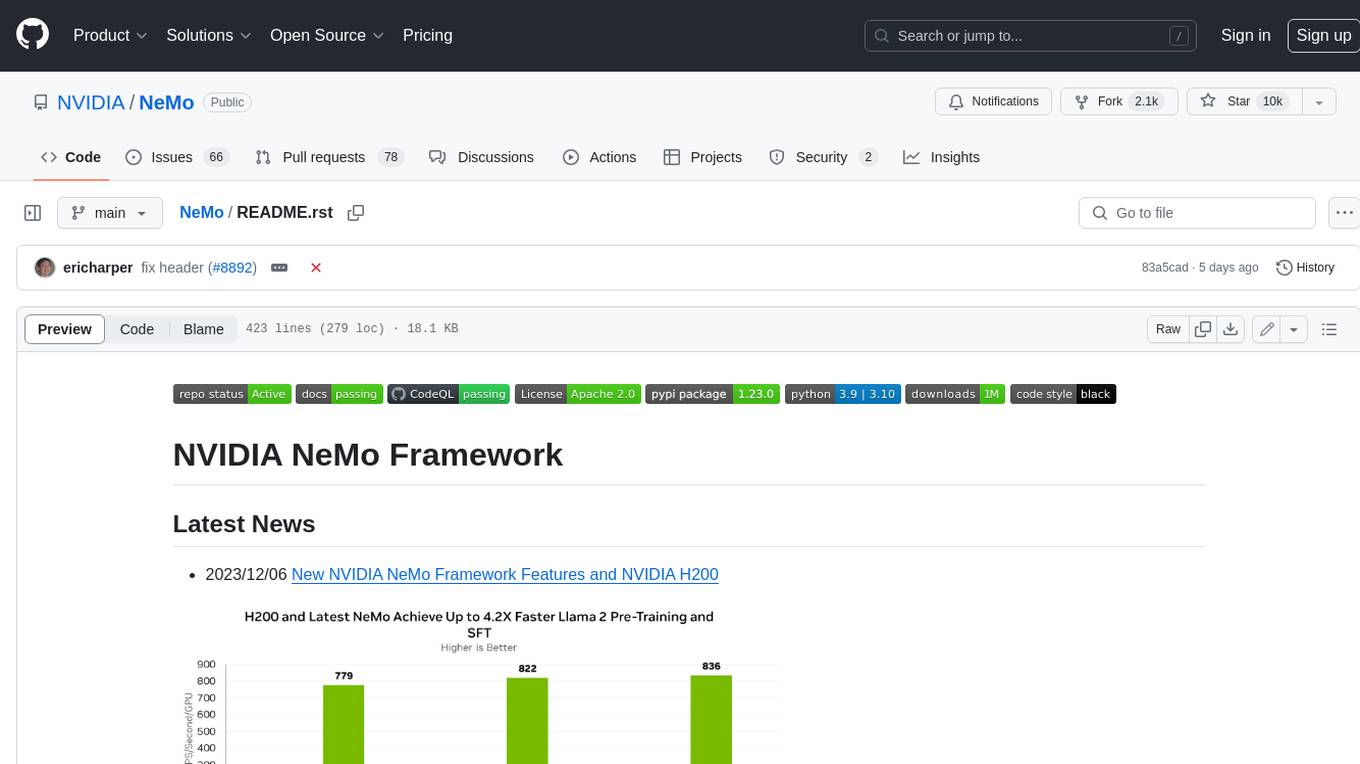
NeMo
NeMo Framework is a generative AI framework built for researchers and pytorch developers working on large language models (LLMs), multimodal models (MM), automatic speech recognition (ASR), and text-to-speech synthesis (TTS). The primary objective of NeMo is to provide a scalable framework for researchers and developers from industry and academia to more easily implement and design new generative AI models by being able to leverage existing code and pretrained models.
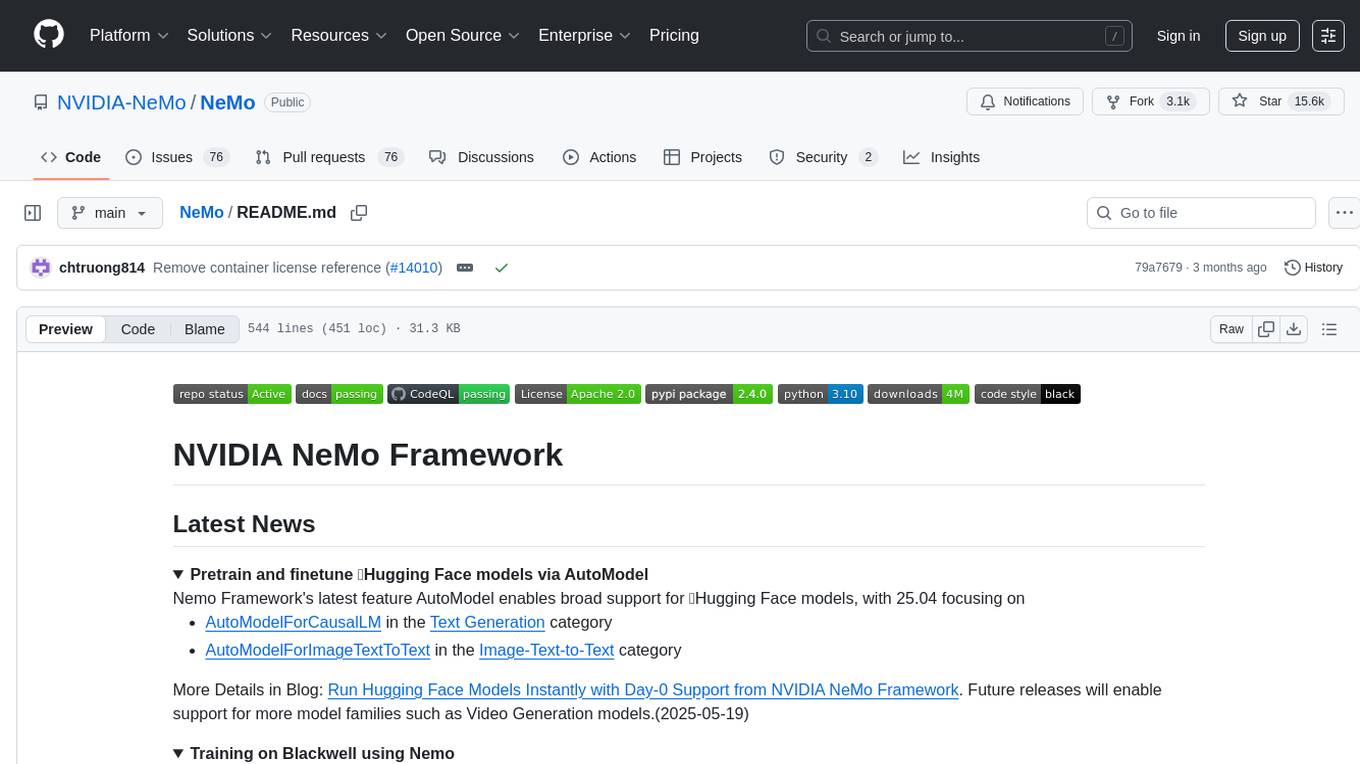
NeMo
NVIDIA NeMo Framework is a scalable and cloud-native generative AI framework built for researchers and PyTorch developers working on Large Language Models (LLMs), Multimodal Models (MMs), Automatic Speech Recognition (ASR), Text to Speech (TTS), and Computer Vision (CV) domains. It is designed to help you efficiently create, customize, and deploy new generative AI models by leveraging existing code and pre-trained model checkpoints.
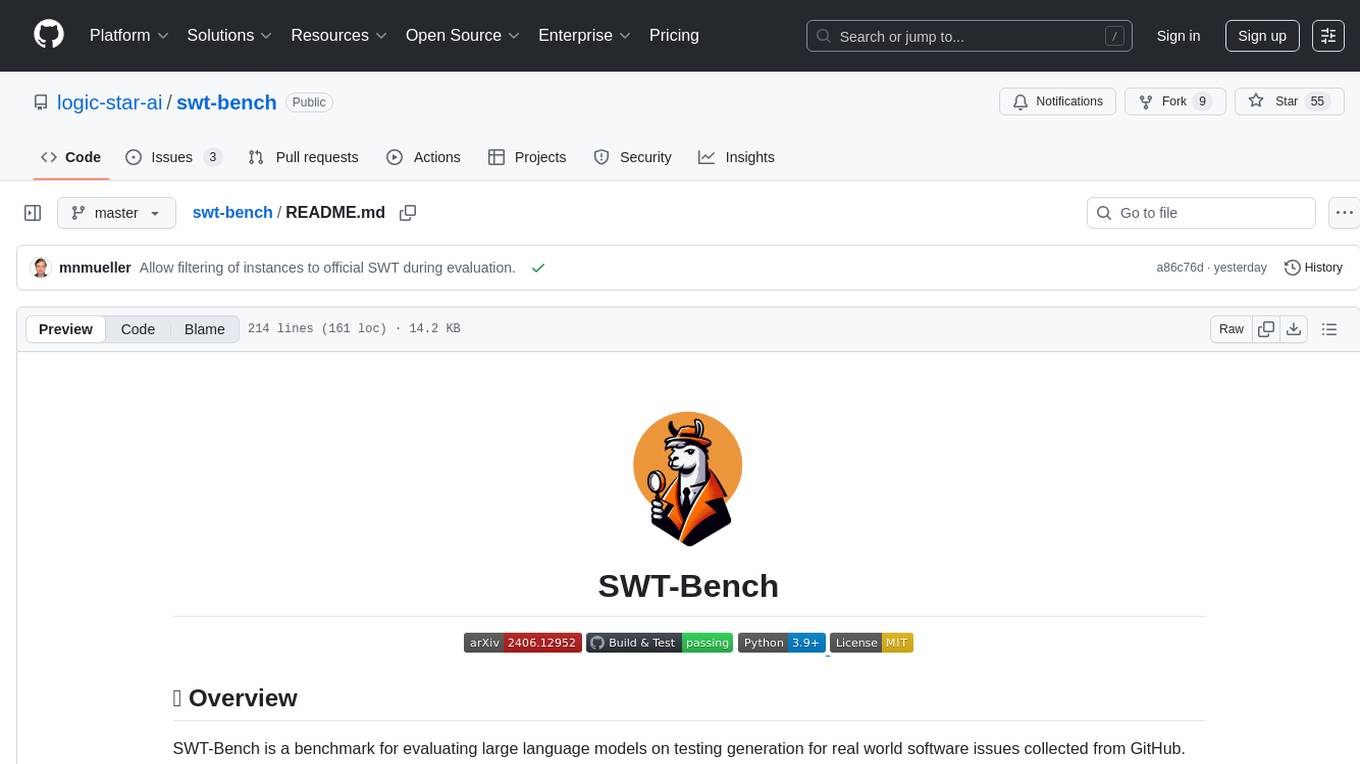
swt-bench
SWT-Bench is a benchmark tool for evaluating large language models on testing generation for real world software issues collected from GitHub. It tasks a language model with generating a reproducing test that fails in the original state of the code base and passes after a patch resolving the issue has been applied. The tool operates in unit test mode or reproduction script mode to assess model predictions and success rates. Users can run evaluations on SWT-Bench Lite using the evaluation harness with specific commands. The tool provides instructions for setting up and building SWT-Bench, as well as guidelines for contributing to the project. It also offers datasets and evaluation results for public access and provides a citation for referencing the work.
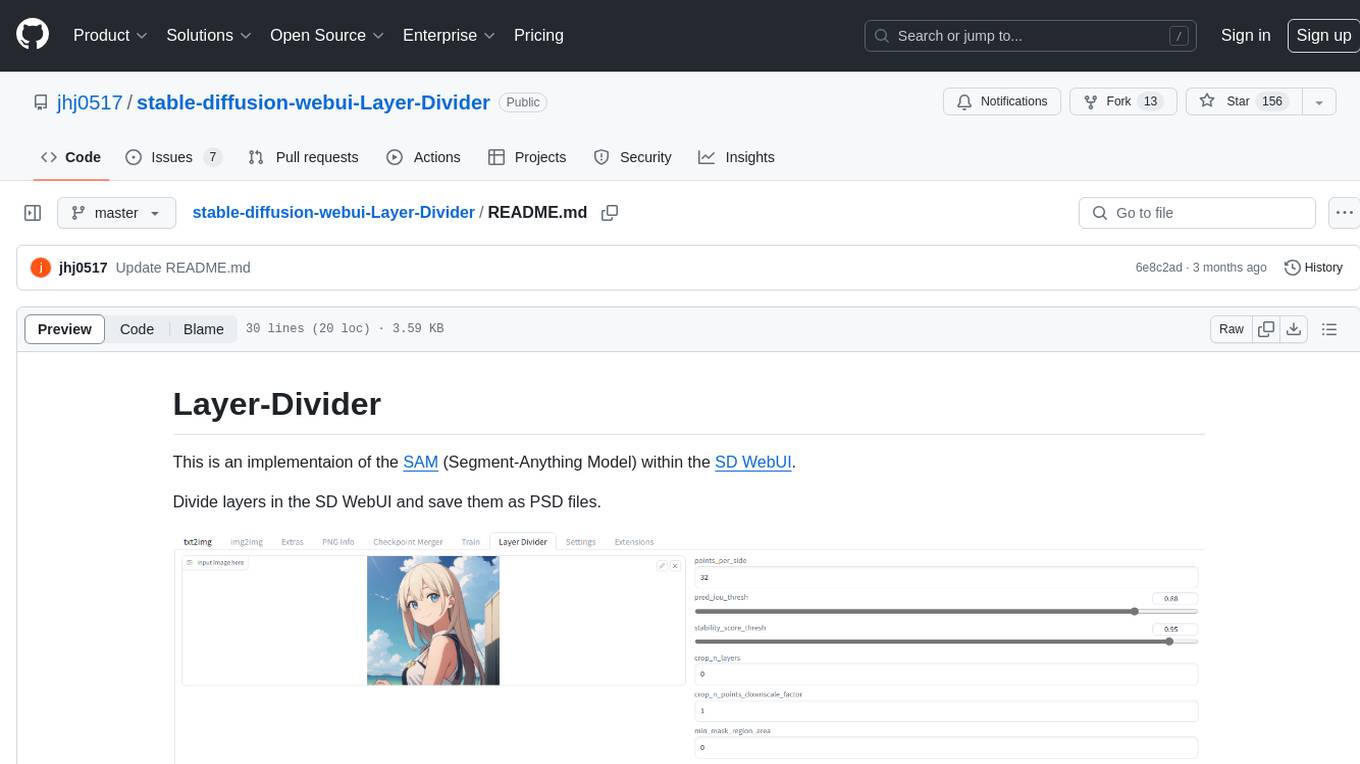
stable-diffusion-webui-Layer-Divider
This repository contains an implementation of the Segment-Anything Model (SAM) within the SD WebUI. It allows users to divide layers in the SD WebUI and save them as PSD files. Users can adjust parameters, click 'Generate', and view the output below. A PSD file will be saved in the designated folder. The tool provides various parameters for customization, such as points_per_side, pred_iou_thresh, stability_score_thresh, crops_n_layers, crop_n_points_downscale_factor, and min_mask_region_area.
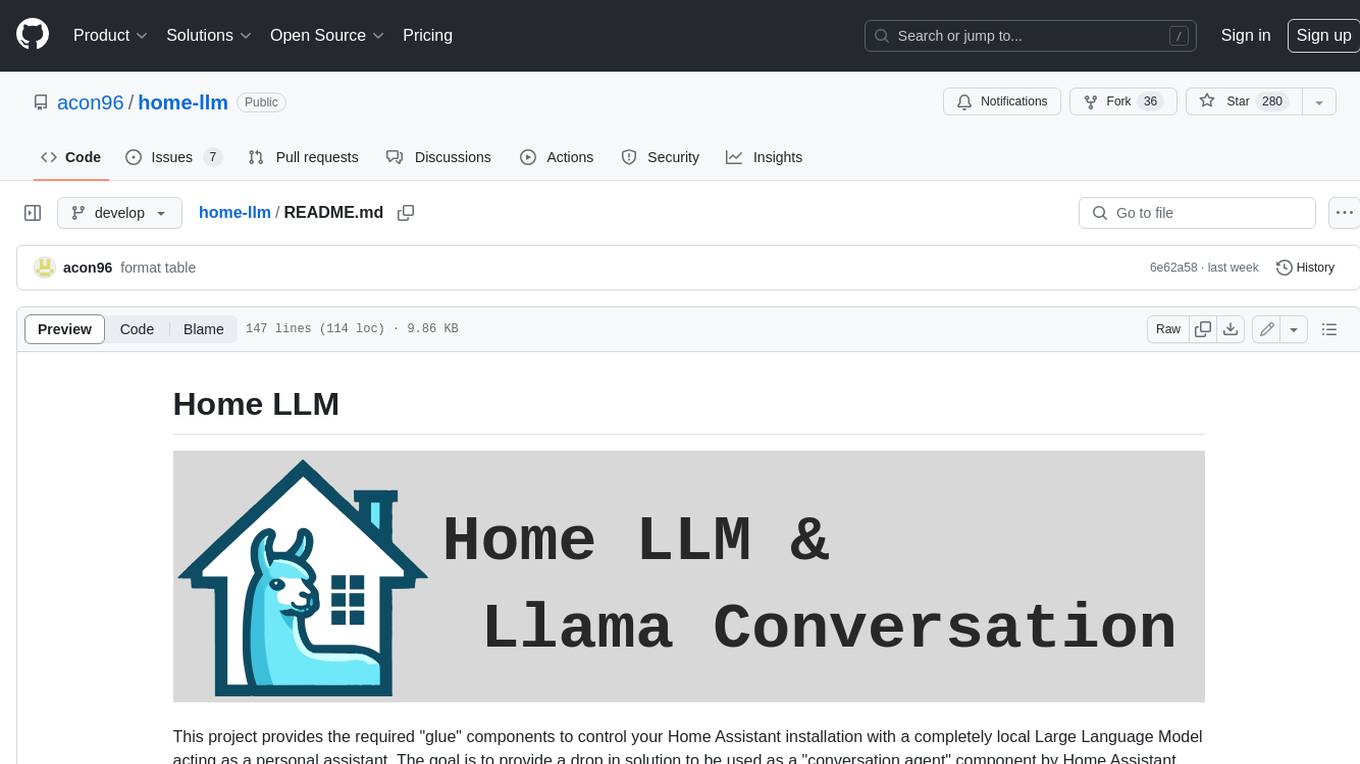
home-llm
Home LLM is a project that provides the necessary components to control your Home Assistant installation with a completely local Large Language Model acting as a personal assistant. The goal is to provide a drop-in solution to be used as a "conversation agent" component by Home Assistant. The 2 main pieces of this solution are Home LLM and Llama Conversation. Home LLM is a fine-tuning of the Phi model series from Microsoft and the StableLM model series from StabilityAI. The model is able to control devices in the user's house as well as perform basic question and answering. The fine-tuning dataset is a custom synthetic dataset designed to teach the model function calling based on the device information in the context. Llama Conversation is a custom component that exposes the locally running LLM as a "conversation agent" in Home Assistant. This component can be interacted with in a few ways: using a chat interface, integrating with Speech-to-Text and Text-to-Speech addons, or running the oobabooga/text-generation-webui project to provide access to the LLM via an API interface.
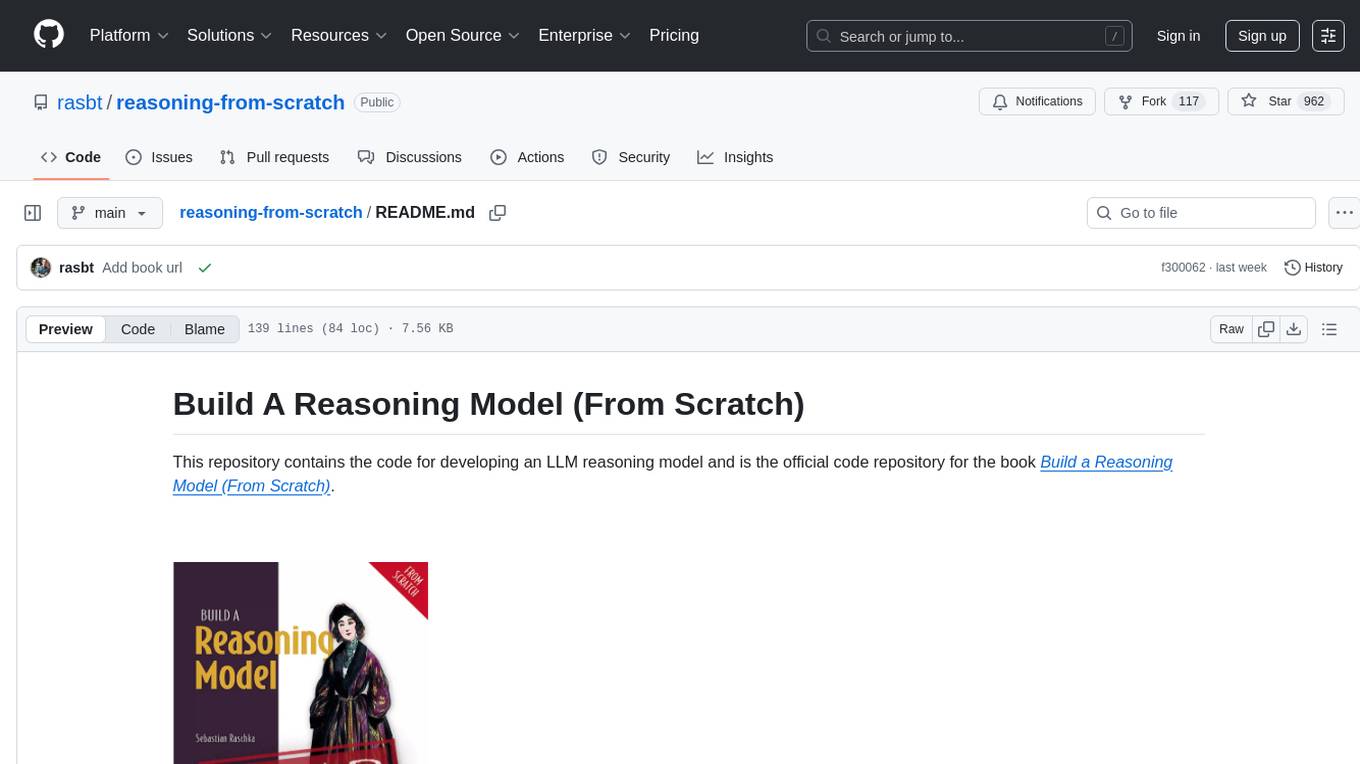
reasoning-from-scratch
This repository contains the code for developing a large language model (LLM) reasoning model. The book 'Build a Reasoning Model (From Scratch)' provides a hands-on approach to understanding and implementing reasoning capabilities in LLMs. It guides users through creating a small but functional reasoning model, mirroring approaches used in large-scale models like DeepSeek R1 and GPT-5 Thinking. The code includes methods for loading weights of pretrained models.
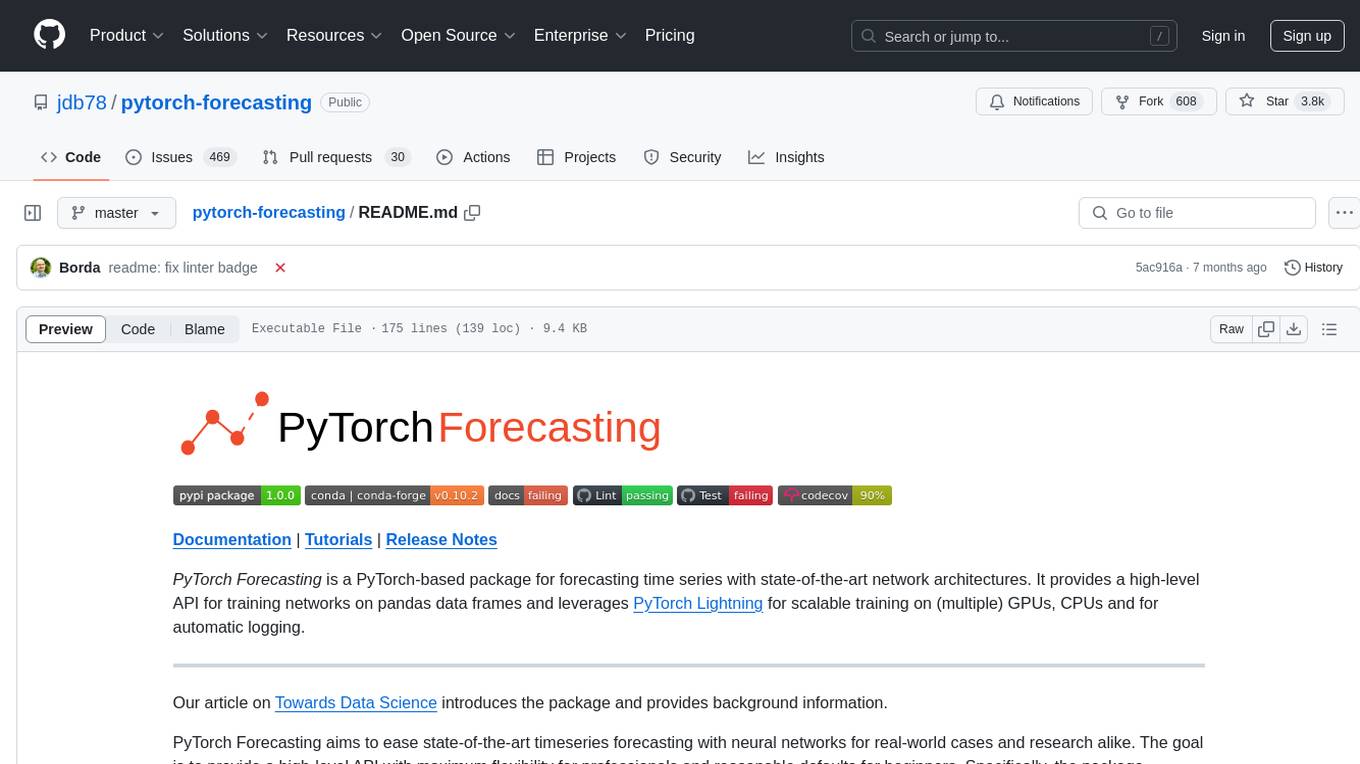
pytorch-forecasting
PyTorch Forecasting is a PyTorch-based package for time series forecasting with state-of-the-art network architectures. It offers a high-level API for training networks on pandas data frames and utilizes PyTorch Lightning for scalable training on GPUs and CPUs. The package aims to simplify time series forecasting with neural networks by providing a flexible API for professionals and default settings for beginners. It includes a timeseries dataset class, base model class, multiple neural network architectures, multi-horizon timeseries metrics, and hyperparameter tuning with optuna. PyTorch Forecasting is built on pytorch-lightning for easy training on various hardware configurations.
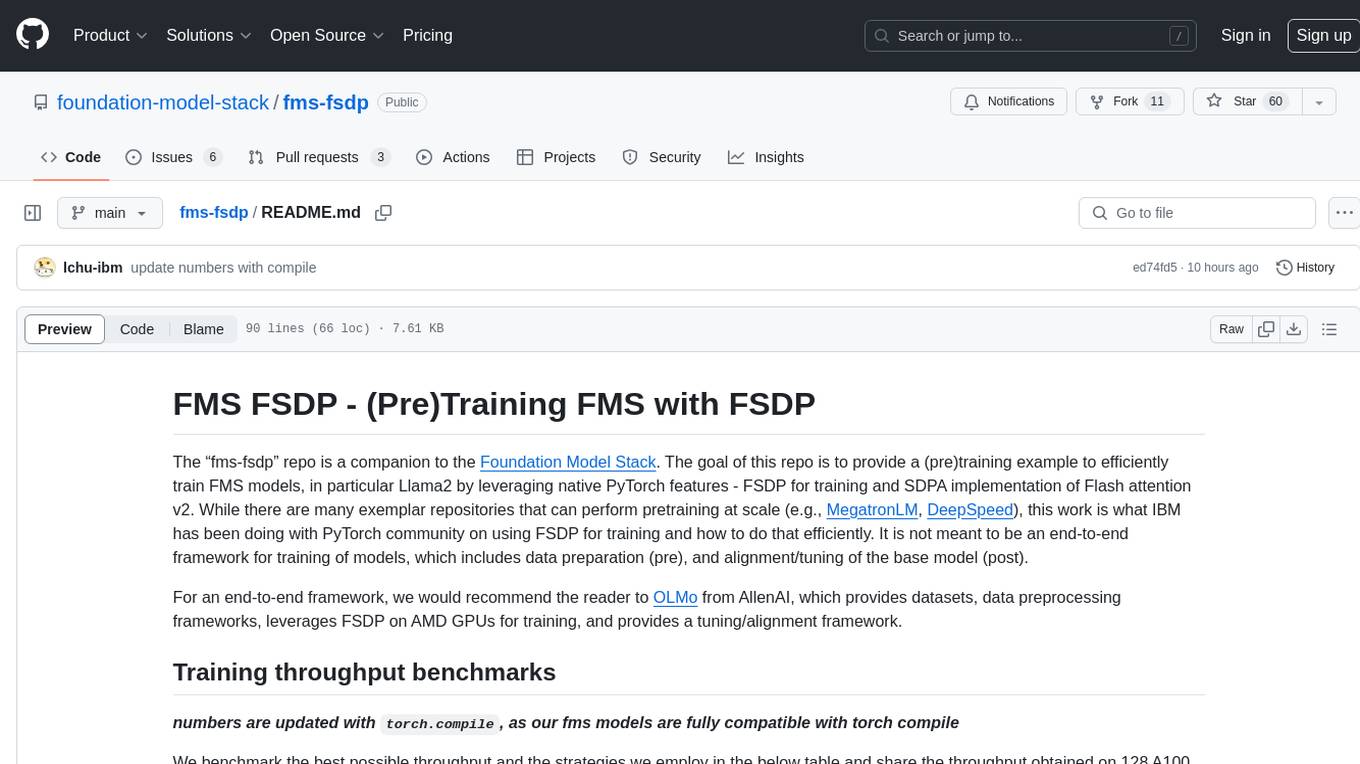
fms-fsdp
The 'fms-fsdp' repository is a companion to the Foundation Model Stack, providing a (pre)training example to efficiently train FMS models, specifically Llama2, using native PyTorch features like FSDP for training and SDPA implementation of Flash attention v2. It focuses on leveraging FSDP for training efficiently, not as an end-to-end framework. The repo benchmarks training throughput on different GPUs, shares strategies, and provides installation and training instructions. It trained a model on IBM curated data achieving high efficiency and performance metrics.
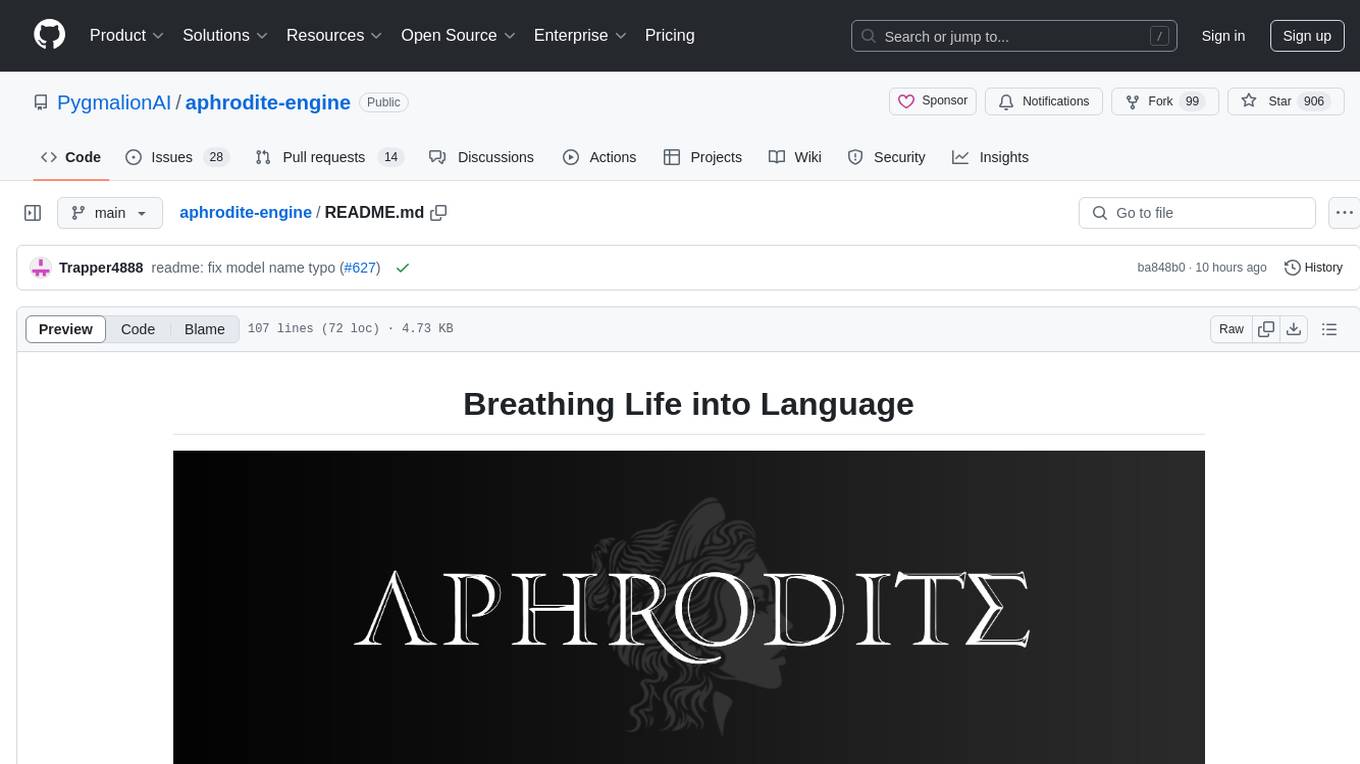
aphrodite-engine
Aphrodite is the official backend engine for PygmalionAI, serving as the inference endpoint for the website. It allows serving Hugging Face-compatible models with fast speeds. Features include continuous batching, efficient K/V management, optimized CUDA kernels, quantization support, distributed inference, and 8-bit KV Cache. The engine requires Linux OS and Python 3.8 to 3.12, with CUDA >= 11 for build requirements. It supports various GPUs, CPUs, TPUs, and Inferentia. Users can limit GPU memory utilization and access full commands via CLI.
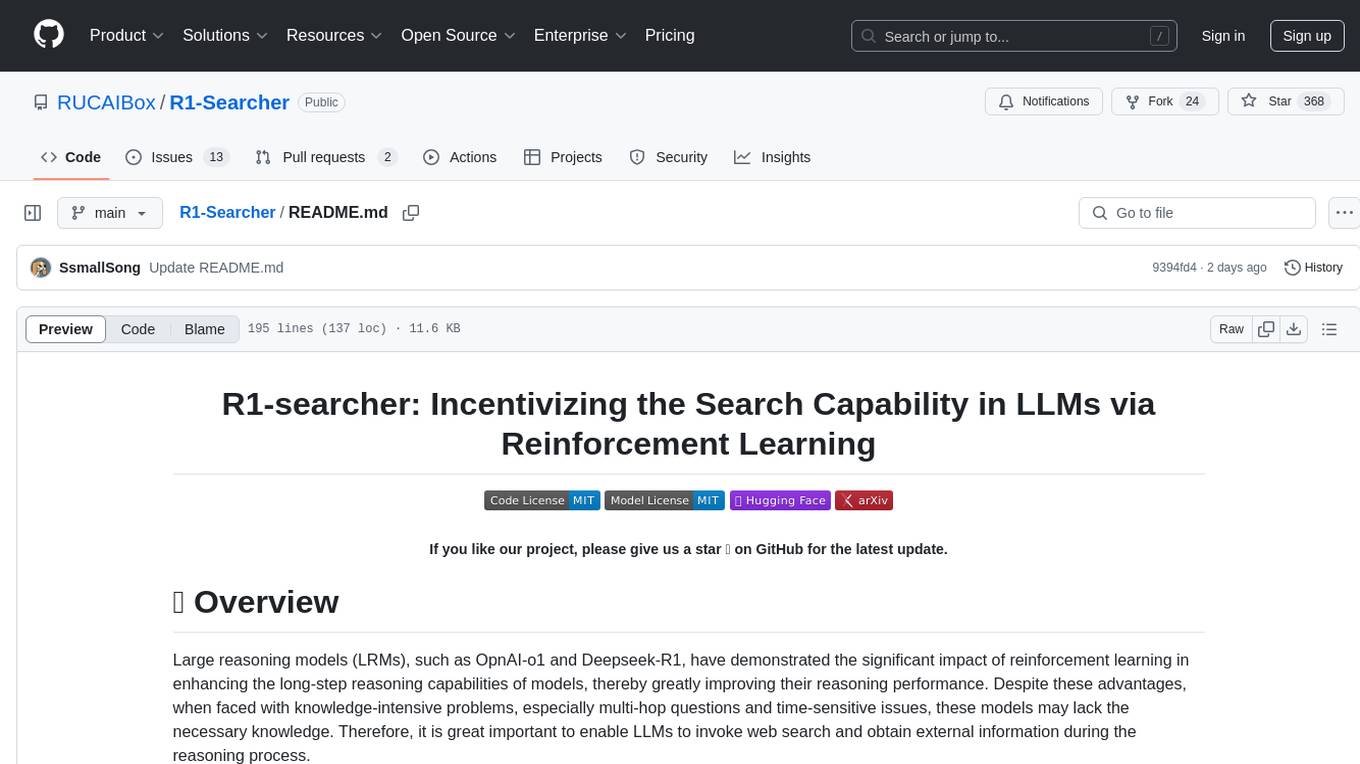
R1-Searcher
R1-searcher is a tool designed to incentivize the search capability in large reasoning models (LRMs) via reinforcement learning. It enables LRMs to invoke web search and obtain external information during the reasoning process by utilizing a two-stage outcome-supervision reinforcement learning approach. The tool does not require instruction fine-tuning for cold start and is compatible with existing Base LLMs or Chat LLMs. It includes training code, inference code, model checkpoints, and a detailed technical report.
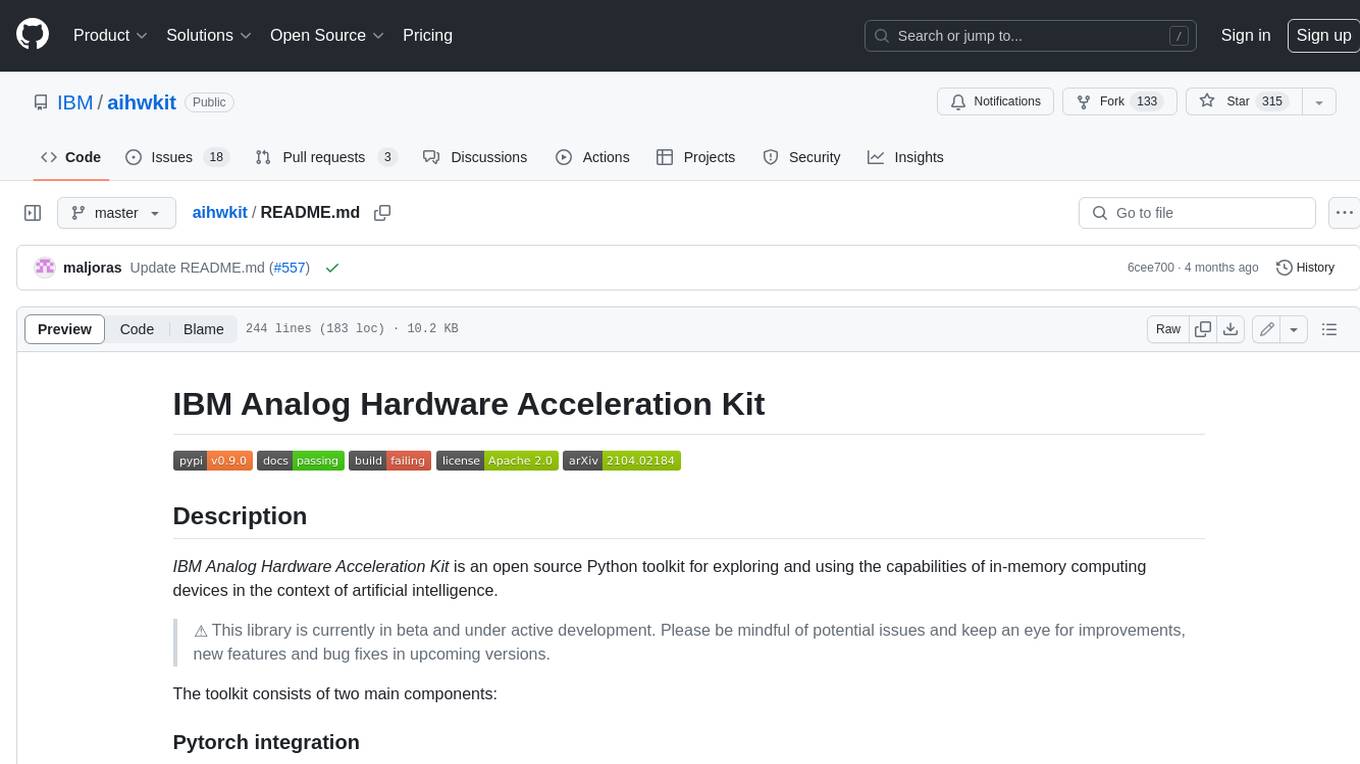
aihwkit
The IBM Analog Hardware Acceleration Kit is an open-source Python toolkit for exploring and using the capabilities of in-memory computing devices in the context of artificial intelligence. It consists of two main components: Pytorch integration and Analog devices simulator. The Pytorch integration provides a series of primitives and features that allow using the toolkit within PyTorch, including analog neural network modules, analog training using torch training workflow, and analog inference using torch inference workflow. The Analog devices simulator is a high-performant (CUDA-capable) C++ simulator that allows for simulating a wide range of analog devices and crossbar configurations by using abstract functional models of material characteristics with adjustable parameters. Along with the two main components, the toolkit includes other functionalities such as a library of device presets, a module for executing high-level use cases, a utility to automatically convert a downloaded model to its equivalent Analog model, and integration with the AIHW Composer platform. The toolkit is currently in beta and under active development, and users are advised to be mindful of potential issues and keep an eye for improvements, new features, and bug fixes in upcoming versions.
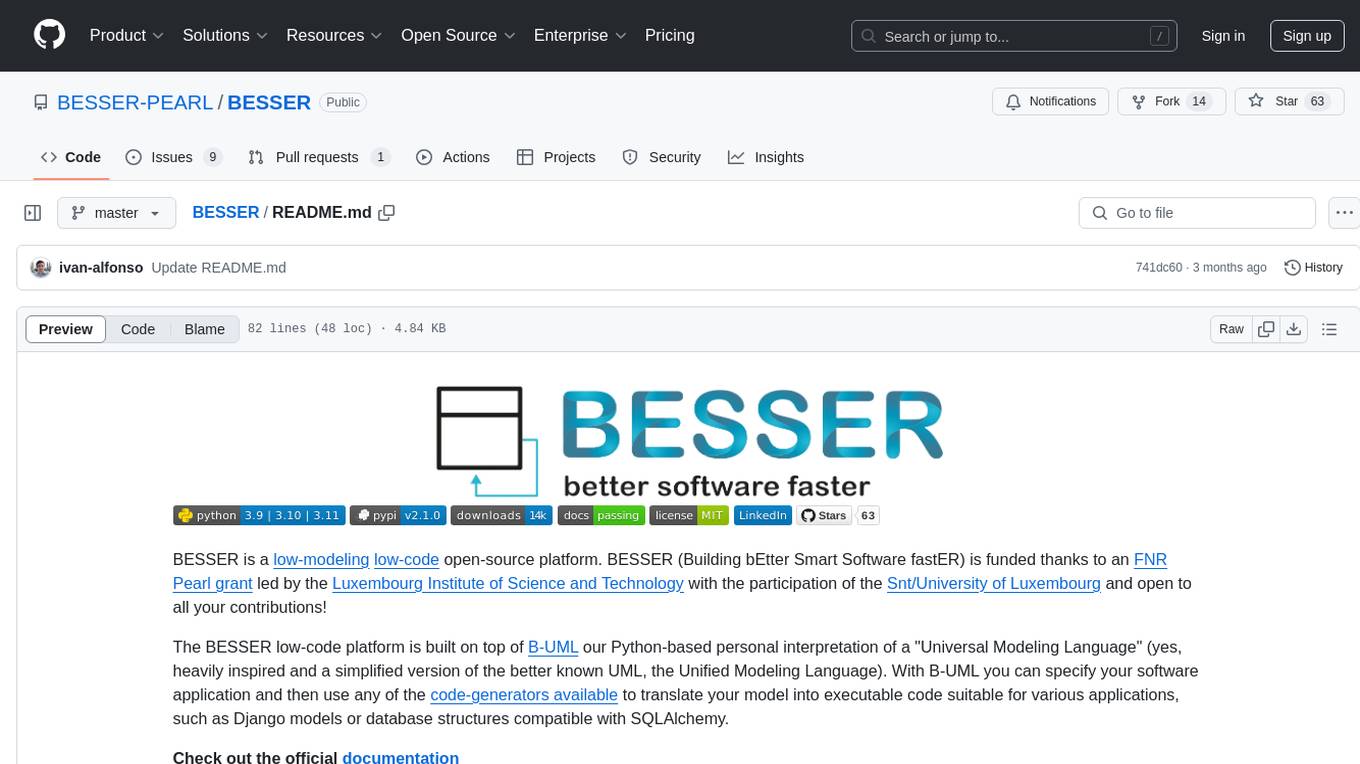
BESSER
BESSER is a low-modeling low-code open-source platform funded by an FNR Pearl grant. It is built on B-UML, a Python-based interpretation of a 'Universal Modeling Language'. Users can specify their software application using B-UML and generate executable code for various applications like Django models or SQLAlchemy-compatible database structures. BESSER is available on PyPi and can be installed with pip. It supports popular Python IDEs and encourages contributions from the community.
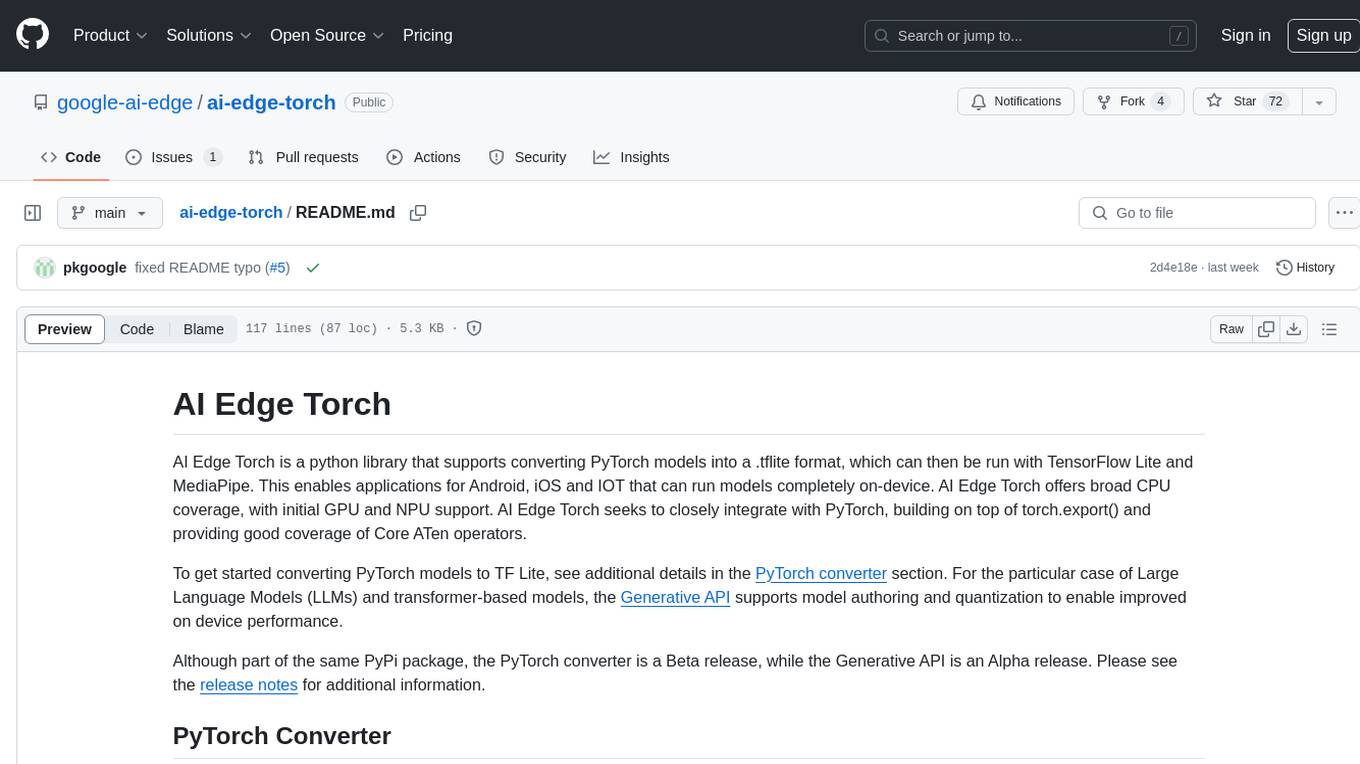
ai-edge-torch
AI Edge Torch is a Python library that supports converting PyTorch models into a .tflite format for on-device applications on Android, iOS, and IoT devices. It offers broad CPU coverage with initial GPU and NPU support, closely integrating with PyTorch and providing good coverage of Core ATen operators. The library includes a PyTorch converter for model conversion and a Generative API for authoring mobile-optimized PyTorch Transformer models, enabling easy deployment of Large Language Models (LLMs) on mobile devices.
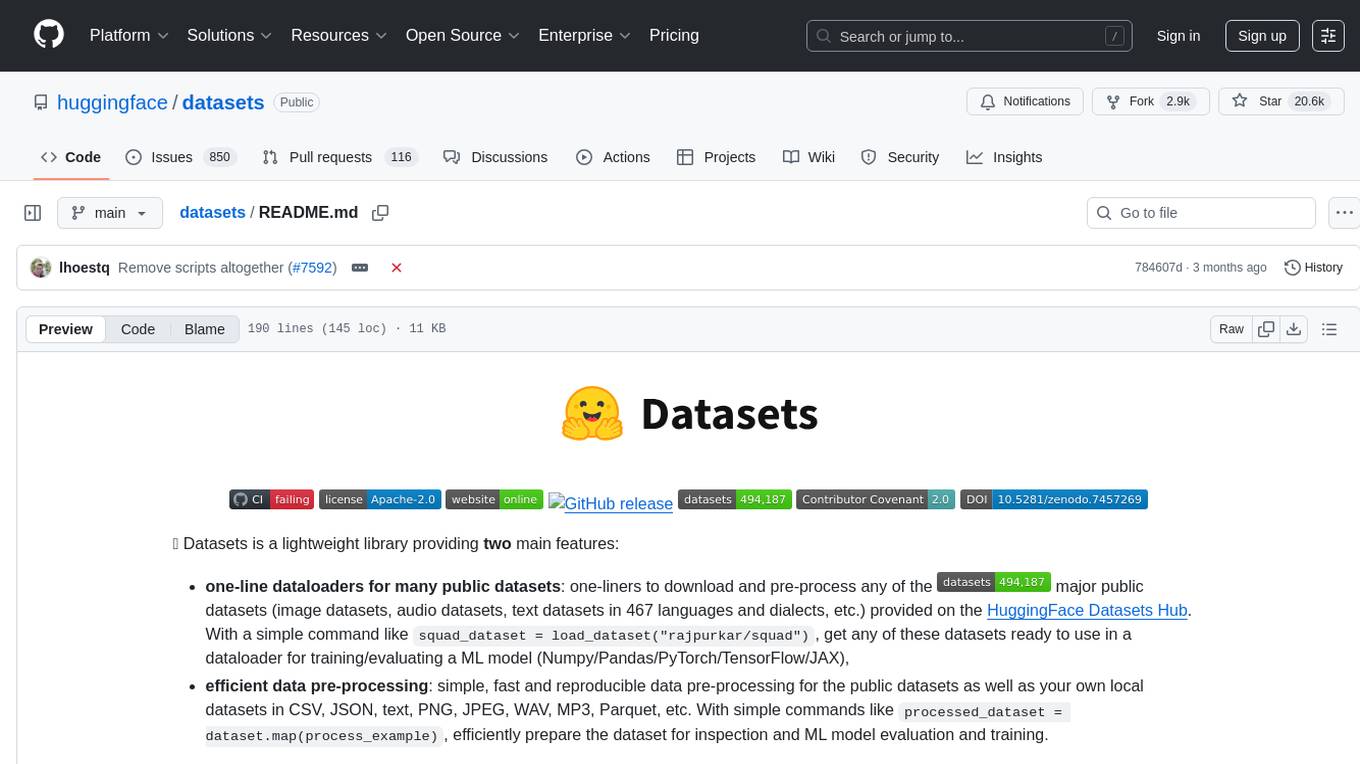
datasets
Datasets is a repository that provides a collection of various datasets for machine learning and data analysis projects. It includes datasets in different formats such as CSV, JSON, and Excel, covering a wide range of topics including finance, healthcare, marketing, and more. The repository aims to help data scientists, researchers, and students access high-quality datasets for training models, conducting experiments, and exploring data analysis techniques.

agentUniverse
agentUniverse is a multi-agent framework based on large language models, providing flexible capabilities for building individual agents. It focuses on collaborative pattern components to solve problems in various fields and integrates domain experience. The framework supports LLM model integration and offers various pattern components like PEER and DOE. Users can easily configure models and set up agents for tasks. agentUniverse aims to assist developers and enterprises in constructing domain-expert-level intelligent agents for seamless collaboration.
For similar tasks

peft
PEFT (Parameter-Efficient Fine-Tuning) is a collection of state-of-the-art methods that enable efficient adaptation of large pretrained models to various downstream applications. By only fine-tuning a small number of extra model parameters instead of all the model's parameters, PEFT significantly decreases the computational and storage costs while achieving performance comparable to fully fine-tuned models.
For similar jobs

spear
SPEAR (Simulator for Photorealistic Embodied AI Research) is a powerful tool for training embodied agents. It features 300 unique virtual indoor environments with 2,566 unique rooms and 17,234 unique objects that can be manipulated individually. Each environment is designed by a professional artist and features detailed geometry, photorealistic materials, and a unique floor plan and object layout. SPEAR is implemented as Unreal Engine assets and provides an OpenAI Gym interface for interacting with the environments via Python.
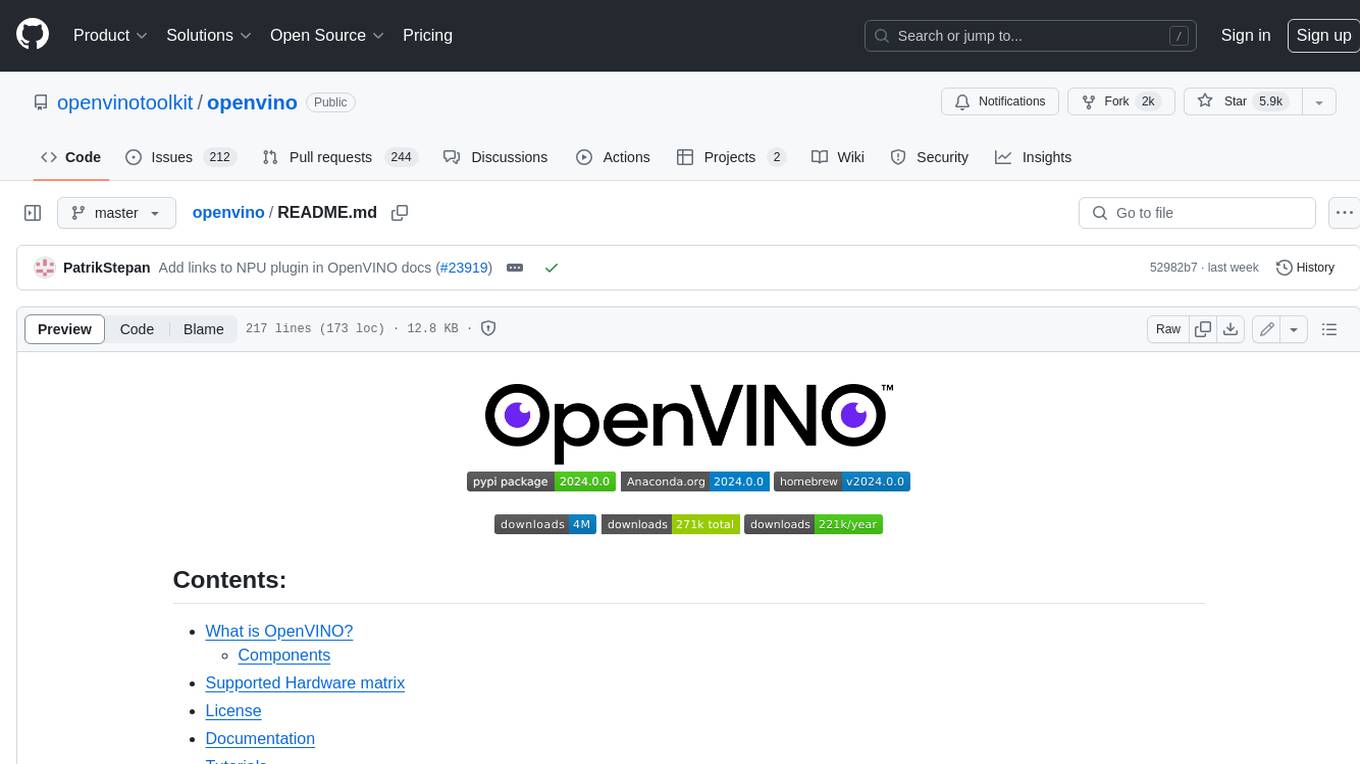
openvino
OpenVINO™ is an open-source toolkit for optimizing and deploying AI inference. It provides a common API to deliver inference solutions on various platforms, including CPU, GPU, NPU, and heterogeneous devices. OpenVINO™ supports pre-trained models from Open Model Zoo and popular frameworks like TensorFlow, PyTorch, and ONNX. Key components of OpenVINO™ include the OpenVINO™ Runtime, plugins for different hardware devices, frontends for reading models from native framework formats, and the OpenVINO Model Converter (OVC) for adjusting models for optimal execution on target devices.

peft
PEFT (Parameter-Efficient Fine-Tuning) is a collection of state-of-the-art methods that enable efficient adaptation of large pretrained models to various downstream applications. By only fine-tuning a small number of extra model parameters instead of all the model's parameters, PEFT significantly decreases the computational and storage costs while achieving performance comparable to fully fine-tuned models.
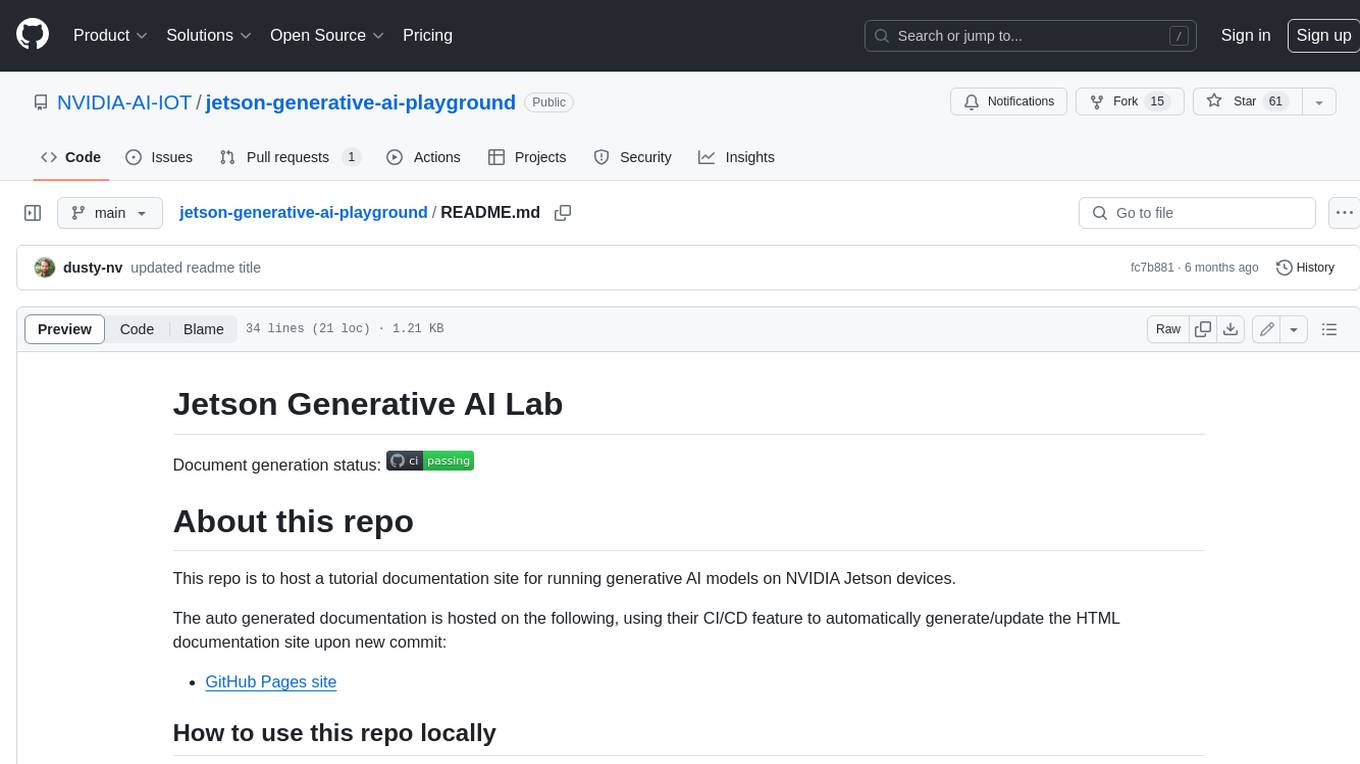
jetson-generative-ai-playground
This repo hosts tutorial documentation for running generative AI models on NVIDIA Jetson devices. The documentation is auto-generated and hosted on GitHub Pages using their CI/CD feature to automatically generate/update the HTML documentation site upon new commits.
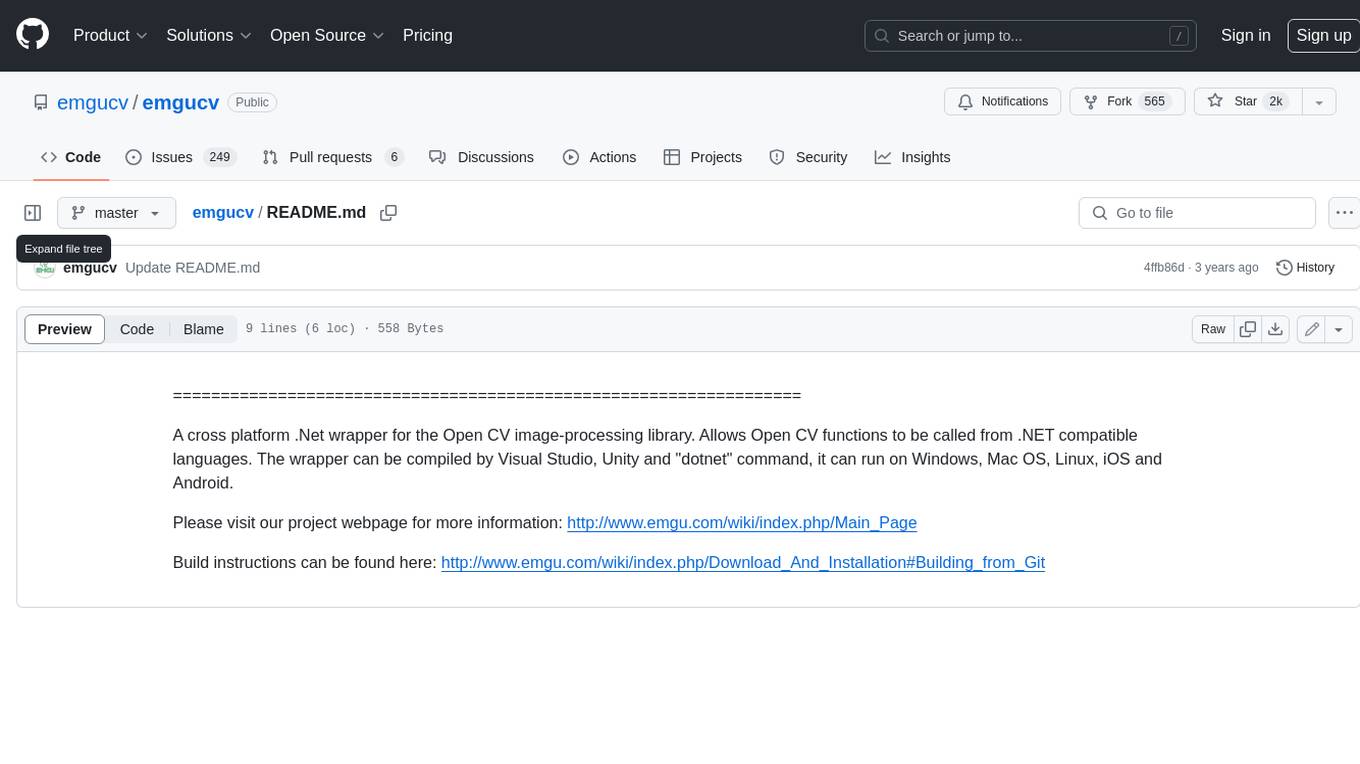
emgucv
Emgu CV is a cross-platform .Net wrapper for the OpenCV image-processing library. It allows OpenCV functions to be called from .NET compatible languages. The wrapper can be compiled by Visual Studio, Unity, and "dotnet" command, and it can run on Windows, Mac OS, Linux, iOS, and Android.
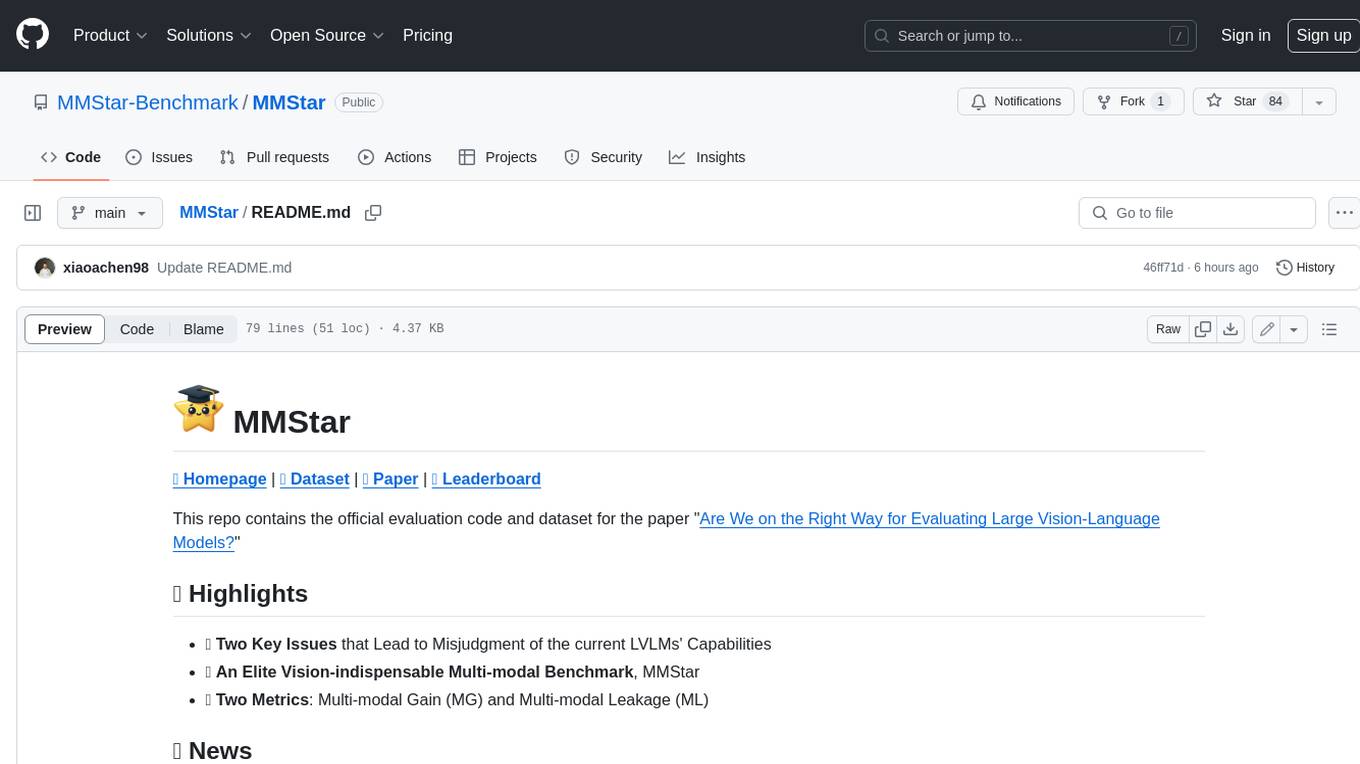
MMStar
MMStar is an elite vision-indispensable multi-modal benchmark comprising 1,500 challenge samples meticulously selected by humans. It addresses two key issues in current LLM evaluation: the unnecessary use of visual content in many samples and the existence of unintentional data leakage in LLM and LVLM training. MMStar evaluates 6 core capabilities across 18 detailed axes, ensuring a balanced distribution of samples across all dimensions.
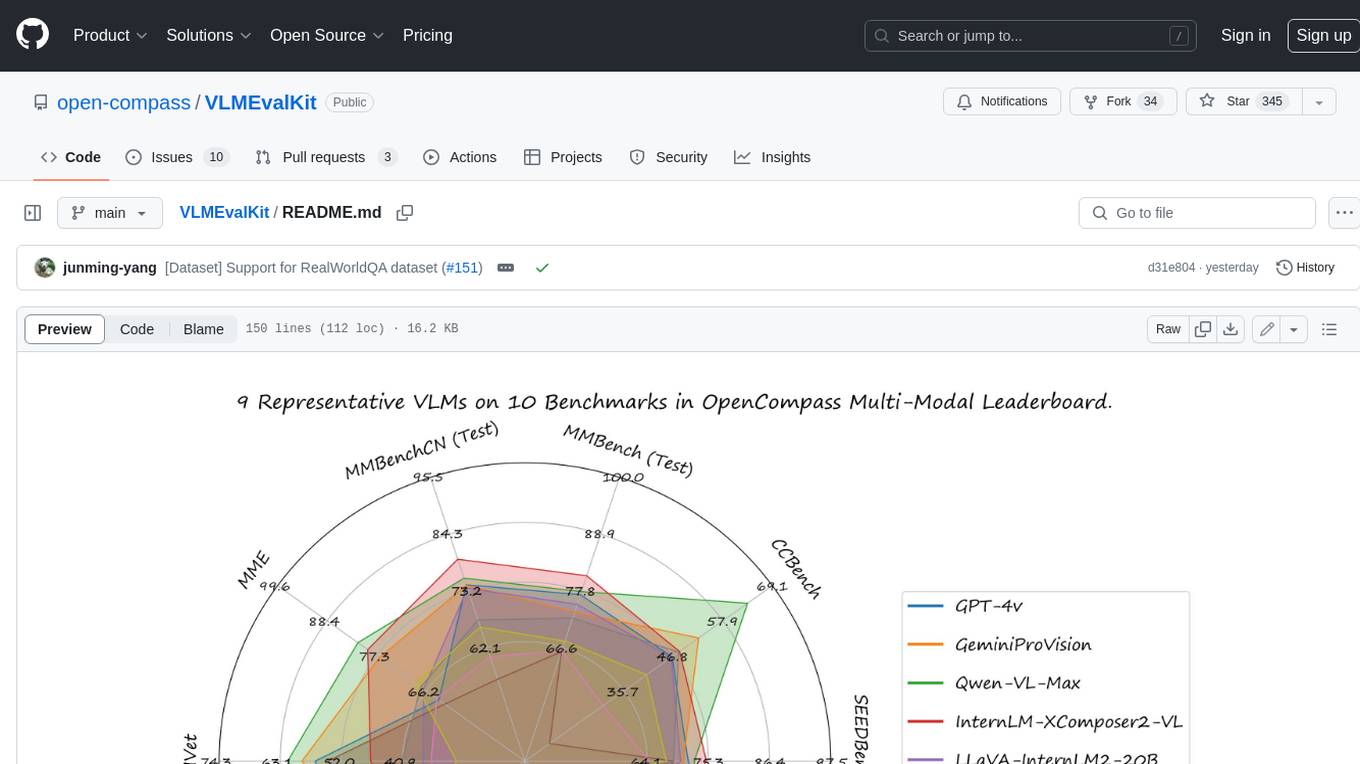
VLMEvalKit
VLMEvalKit is an open-source evaluation toolkit of large vision-language models (LVLMs). It enables one-command evaluation of LVLMs on various benchmarks, without the heavy workload of data preparation under multiple repositories. In VLMEvalKit, we adopt generation-based evaluation for all LVLMs, and provide the evaluation results obtained with both exact matching and LLM-based answer extraction.
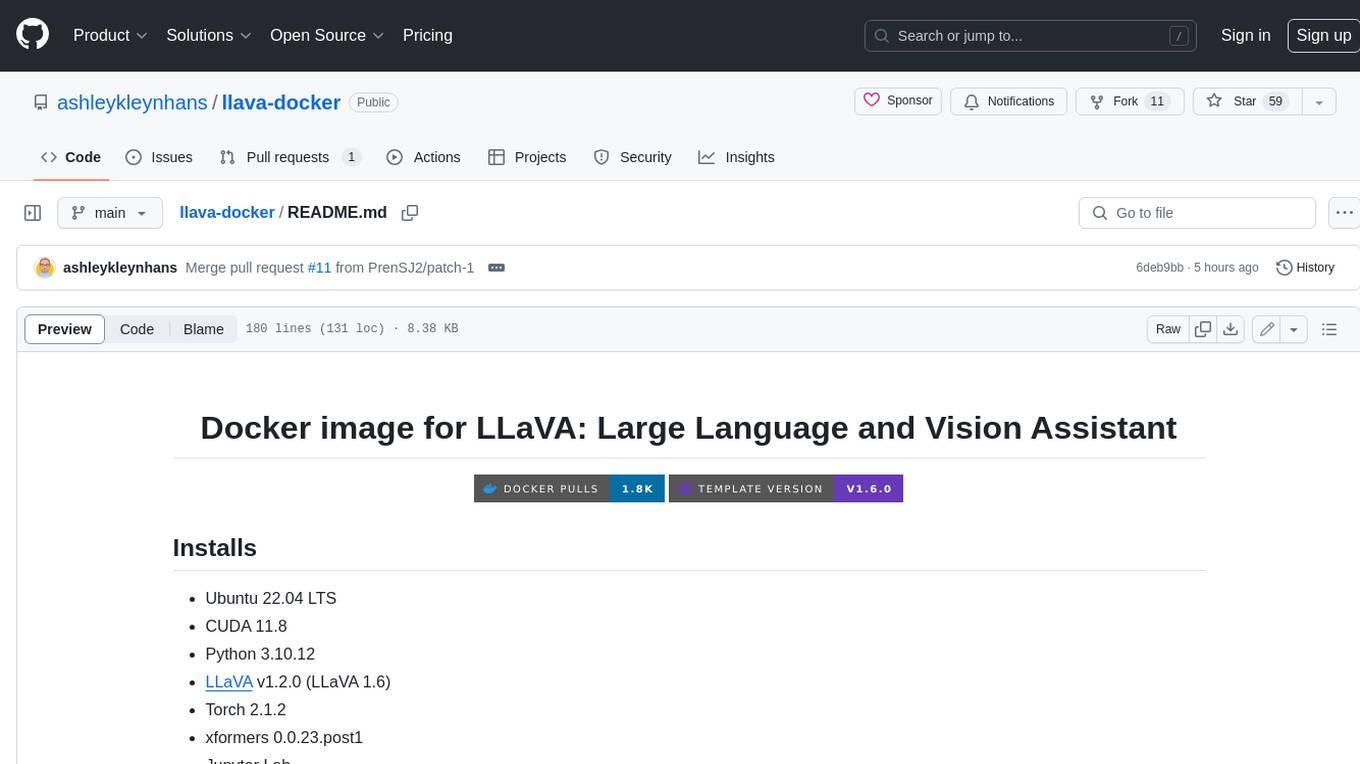
llava-docker
This Docker image for LLaVA (Large Language and Vision Assistant) provides a convenient way to run LLaVA locally or on RunPod. LLaVA is a powerful AI tool that combines natural language processing and computer vision capabilities. With this Docker image, you can easily access LLaVA's functionalities for various tasks, including image captioning, visual question answering, text summarization, and more. The image comes pre-installed with LLaVA v1.2.0, Torch 2.1.2, xformers 0.0.23.post1, and other necessary dependencies. You can customize the model used by setting the MODEL environment variable. The image also includes a Jupyter Lab environment for interactive development and exploration. Overall, this Docker image offers a comprehensive and user-friendly platform for leveraging LLaVA's capabilities.